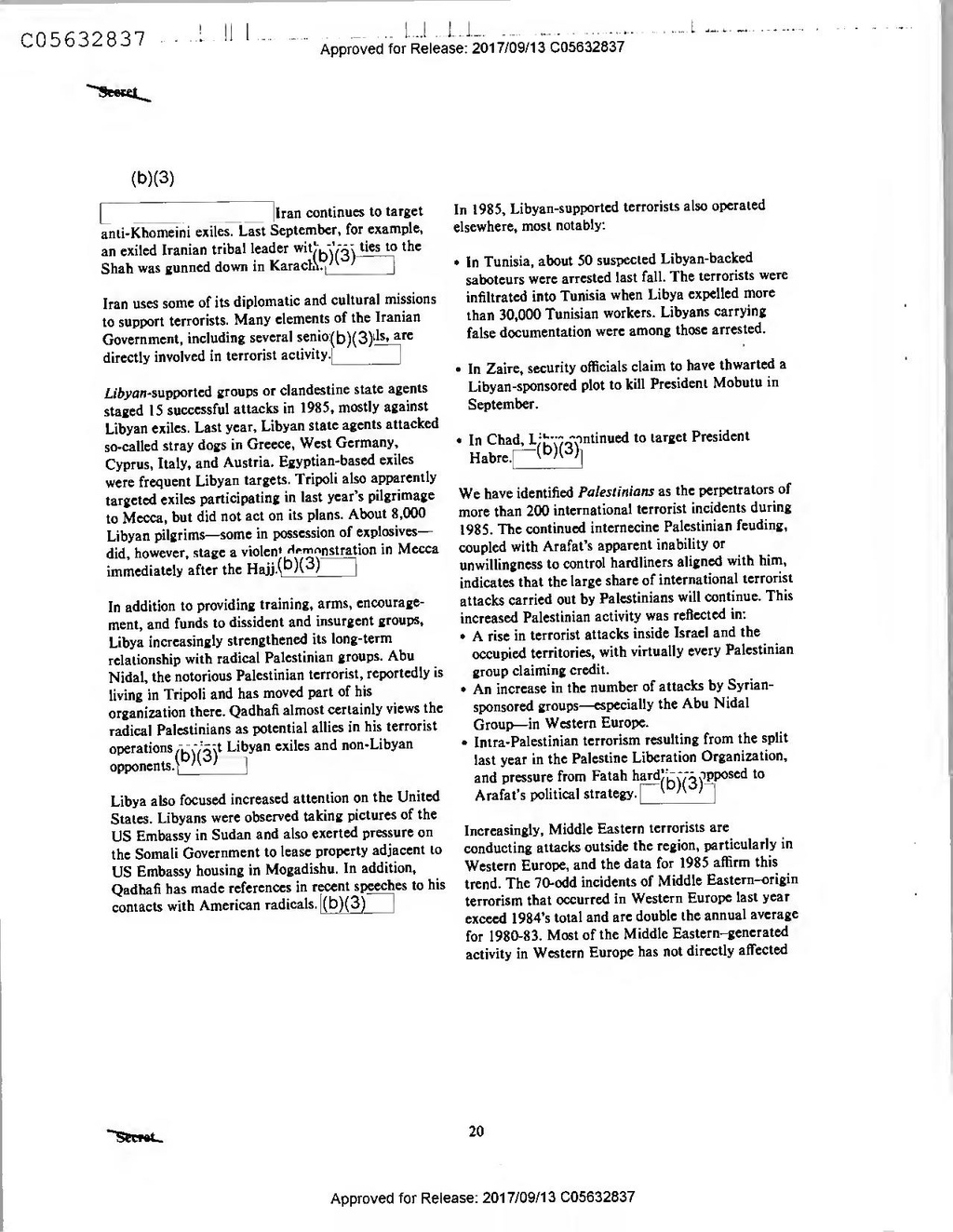Secret
(b)(3)
In 1985, Libyan-supported terrorists also operated elsewhere, most notably:
Iran continues to target anti-Khomeini exiles. Last September, for example, an exiled Iranian tribal leader Shah was gunned down in
kb)(3)
ties to the Iran uses some of its diplomatic and cultural missions to support terrorists. Many elements of the Iranian Government, including several senio(b)(3)ıls, are directly involved in terrorist activity.
• In Tunisia, about 50 suspected Libyan-backed
saboteurs were arrested last fall. The terrorists were infiltrated into Tunisia when Libya expelled more than 30,000 Tunisian workers. Libyans carrying false documentation were among those arrested.
• In Zaire, security officials claim to have thwarted a
Libyan-sponsored plot to kill President Mobutu in September.
• In Chad, Lihontinued to target President
Habre.
(b)(3)
Libyan-supported groups or clandestine state agents staged 15 successfUL attacks in 1985, mostly against Libyan exiles. Last year, Libyan state agents attacked so-called stray dogs in Greece, West Germany, Cyprus, Italy, and Austria. Egyptian-based exiles were frequent Libyan targets. Tripoli also apparently targeted exiles participating in last year's pilgrimage to Mecca, but did not act on its plans. About 8,000 Libyan pilgrims—some in possession of explosives— did, however, stage a violent demonstration in Mecca immediately after the Hajj.(b)(3)
In addition to providing training, arms, encouragement, and funds to dissident and insurgent groups, Libya increasingly strengthened its long-term relationship with radical Palestinian groups. Abu Nidal, the notorious Palestinian terrorist, reportedly is living in Tripoli and has moved part of his organization there. Qadhafi almost certainly views the radical Palestinians as potential allies in his terrorist
We have identified Palestinians as the perpetrators of more than 200 international terrorist incidents during 1985. The continued internecine Palestinian feuding, coupled with Arafat's apparent inability or unwillingness to control hardliners aligned with him, indicates that the large share of international terrorist attacks carried out by Palestinians will continue. This increased Palestinian activity was reflected in: • A rise in terrorist attacks inside Israel and the
occupied territories, with virtually every Palestinian
group claiming credit. • An increase in the number of attacks by Syriansponsored groups especially the Abu Nidal
Groupin Western Europe. • Intra-Palestinian terrorism resulting from the split
last year in the Palestine Liberation Organization, and pressure from Fatah hard' Arafat's political strategy.
operations (b)(3) Libyan exiles and non-Libyan
opponents.
(b)(3) pposed to
Libya also focused increased attention on the United States. Libyans were observed taking pictures of the US Embassy in Sudan and also exerted pressure on the Somali Government to lease property adjacent to US Embassy housing in Mogadishu. In addition, Qadhafi has made references in recent speeches to his contacts with American radicals. (b)(3)
Increasingly, Middle Eastern terrorists are conducting attacks outside the region, particularly in Western Europe, and the data for 1985 affirm this trend. The 70-odd incidents of Middle Eastern-origin terrorism that occurred in Western Europe last year exceed 1984's total and are double the annual average for 1980-83. Most of the Middle Eastern-generated activity in Western Europe has not directly affected
20
Secret
Approved for Release: 2017/09/13 C05632837
